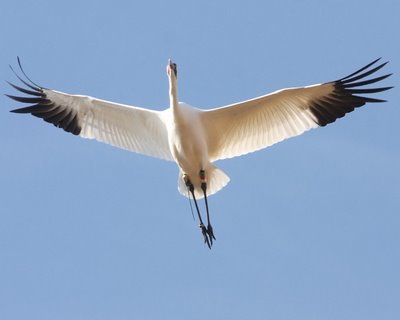
Whooping Crane Background
Grus
Americana, or Whooping Crane, is the largest migrating bird in North
America, with males reaching up to 1.5 meters (5 feet). While there are several
small populations around the continent, the only wild, self-sustaining
population is the Aransas-Wood Buffalo Population (AWBP). These bi-migratory
birds leave their breeding grounds in Wood Buffalo National Park, Canada in
mid-September and arrive at Aransas Nature Preserve on the Texas coast between
late October and mid-November. Historically, whooping cranes were found across
much of North and Central America, but after years of Human interactions with
the landscape in the Great Plains region, the whooping cranes’ range has been
restricted to the 2,400 mile long and 220 mile wide corridor between Canada and
Texas. This migration corridor encompasses 95% of whooping crane sightings.
Causes of Endangerment and Continuing Threats
The primary threat to whooping
crane populations is human settlement and agricultural practices. Both of these
severely degrade whooping crane habitats which has greatly restricted their
range. Other threats include water-way alterations, human accessibility,
diseases and parasites, predation, and other disturbances. Whooping crane habitat,
especially the wintering grounds on the Texas coast, require specific salinity
levels, and fresh water inflows to the coastal wetlands provide these levels. The
various flora and fauna eaten by whooping cranes also thrive in this kind of
environment. Increase in human settlement and drought have created a heavier
load on freshwater supplies, making it difficult for enough freshwater to reach
Aransas. In addition, Aransas National Wildlife Refuge is easily accessible to
humans, and whooping cranes are particularly sensitive to disturbance – if disturbed,
it is unlikely a whooping crane will return to the same area. Other disturbances
related to human activity include environmental alteration, erection of power
lines, which cranes run into often during migration, and shootings, whether it
be accidental or intentional. The whooping crane was first listed as endangered in 1967, and the most recent recovery plan was aproved in 2013.
Habitat and Conservation
Whooping crane habitats consist of wetlands
and prairies, lakes, wet meadows and rivers, coastal marshes, salt and tidal
flats, and barrier islands. The draining of the prairies in the Great Plains
region of the United States and Canada has greatly restricted whooping cranes
over the last hundred years. The AWBP has exhibited what can only be described
as stubbornness; they have resolutely stayed within their historical breeding
grounds in Canada. Some biologists believe this has contributed to the
population’s success; the reasoning behind this claim being somewhat related to
chance. Wood Buffalo National Park, established in the early 1900s, was created
in an attempt to protect the Wood Bison native to that area. Later, the AWBP
was found in the northern section of the park. Other conservation efforts include
legislation that prevents the hunting of certain migratory birds – enacted both
in the U.S. and Canada – as well as classifying whooping cranes as endangered
under the Endangered Species Act (ESA) and its Canadian counterpart, cultivating
captive populations for introduction into the wild, minimizing threats to
current populations, and maintaining the growth of AWBP.
The ultimate goal of the recovery plan
is to delist the whooping crane. Steps being taken, as funding allows, to reach
this goal include enhancing habitat used for breeding, migrating, and wintering
in the hopes of reaching a genetically stable population (the exact population
size to reach genetic stability has yet to be calculated), the introduction of
other wild, self-sufficient populations that are geographically separate from
the Aransas-Wood Buffalo Population, and maintaining captive breeding programs.
What Can You Do?
If you
see a whooping crane in the wild, be sure to treat it with respect and don’t
approach it, and definitely don’t shoot it. Just enjoy the fact that you’re in
the presence of bird nearly as tall as you are. If you want to help the
whooping crane more directly, support the U.S. Fish and Wildlife service or
write to your senator or representatives about preserving this majestic
creature.
Works Cited
http://www.fws.gov/northflorida/whoopingcrane/whoopingcrane-fact-2001.htm


No comments:
Post a Comment